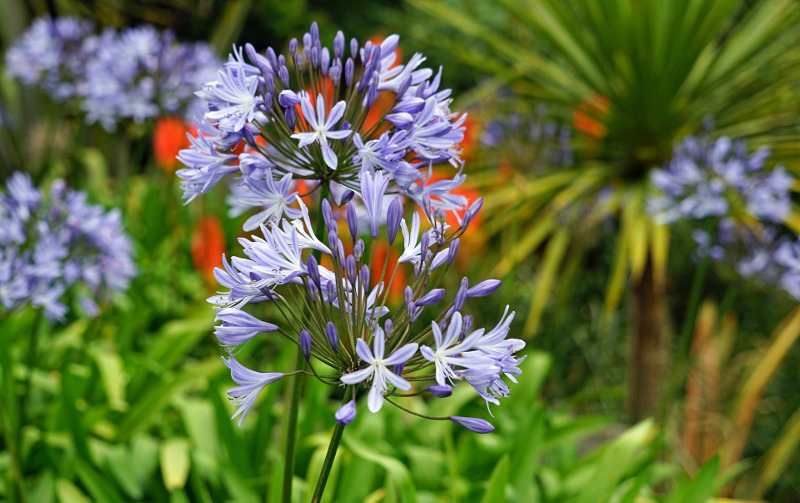How to Plant and Maintain Agapanthus in Your Garden
How to Plant and Maintain Agapanthus in Your Garden
Blog Article
Mastering the Art of Agapanthus Care: Essential Steps for Healthy Growth and Lively Blooms
In the world of horticulture, the growing of agapanthus stands as a fulfilling endeavor for those that look for to nurture these elegant flowering plants. From picking the right range to understanding pruning strategies, the trip in the direction of cultivating growing agapanthus plants is complex and holds the key to unlocking the complete possibility of these botanical treasures.

Picking the Right Agapanthus Variety

When choosing the right Agapanthus range for your yard, consider aspects such as climate suitability, flower shade, and development behavior. Agapanthus, typically referred to as Lily of the Nile or African lily, is available in a selection of colors ranging from shades of purple and blue to white. Choose a bloom shade that enhances your existing yard combination to produce an unified landscape. Additionally, consider the environment in your area to make certain the Agapanthus variety you choose can flourish in your particular problems. Some varieties are extra tolerant of chilly temperature levels, while others favor warmer environments. Recognizing the growth habit of various Agapanthus selections is important for correct placement within your yard. Some selections have a clumping development behavior, perfect for containers or borders, while others have a more spreading nature, ideal for ground cover or mass growings. By carefully evaluating these variables, you can pick the ideal Agapanthus selection to boost the elegance of your garden.
Suitable Planting Problems
Thinking about the optimum environmental demands is important for successful Agapanthus farming. Agapanthus grows in well-draining dirt with a slightly acidic to neutral pH degree. When growing, choose a place that gets complete sunlight to partial color. In hotter environments, supplying some afternoon color can stop scorching of the fallen leaves. Agapanthus plants are sensitive to chilly temperature levels and need to be secured from frost throughout cold weather.
To make sure healthy growth and dynamic flowers, plant Agapanthus light bulbs at a depth of regarding 2-4 inches and room them 8-12 inches apart. Mulching around the base of the plants assists preserve wetness and subdues weed development.
Watering and Fertilizing Tips
Keeping appropriate wetness levels and giving vital nutrients are crucial elements in the treatment program for Agapanthus plants. It is essential to strike an equilibrium when it comes to sprinkling Agapanthus. If overwatered, these plants favor constantly wet dirt however are vulnerable to root i loved this rot. Throughout the expanding period, water deeply when a week, making certain the dirt is well-draining to stop waterlogging. In hotter environments or throughout periods of drought, more constant watering might be necessary to maintain the soil evenly damp. Nevertheless, reduce watering in the winter to protect against waterlogged conditions.
Fertilizing Agapanthus is necessary for advertising healthy and balanced development and respected blossoms. Apply a balanced plant food, such as a 10-10-10 formula, in the early springtime as new development emerges. By adhering to these watering and feeding ideas, you can ensure your Agapanthus plants flourish and generate vivid, find out here resilient flowers.
Pruning Techniques for Agapanthus
Trimming Agapanthus plants at the appropriate times and with appropriate techniques is essential for keeping their health and wellness and advertising optimal development and flowering. The suitable time to prune Agapanthus is in late winter or early springtime prior to new development arises.
Deadheading invested blossoms can likewise reroute the plant's energy into generating even more flowers rather than setting seeds. If you desire to accumulate seeds for propagation, leave some flowers to fully grown and dry on the plant.
Keep in mind to utilize clean, sharp devices to make specific cuts and lower the risk of introducing diseases. Agapanthus. Routine trimming will certainly help keep your Agapanthus looking cool and healthy and balanced while guaranteeing a bountiful screen of attractive blooms
Handling Common Pests and Illness
After making sure appropriate pruning strategies for Agapanthus, it is crucial to resolve usual pests and diseases that can influence the health and vitality of these plants. One common bug that influences Agapanthus is the Agapanthus gall midget.
An additional common concern is fungal pop over to this site fallen leave spot, which offers as dark sores on the leaves. To prevent fungal diseases, make certain good air blood circulation around the plants, prevent overhead watering, and get rid of any infected leaves without delay. Furthermore, Agapanthus plants can deal with origin rot if they are planted in inadequately draining pipes soil. To avoid this, plant Agapanthus in well-draining dirt and stay clear of overwatering. By being alert and taking punctual action against bugs and diseases, you can aid your Agapanthus plants prosper and produce vivid flowers.

Final Thought
To conclude, mastering the art of agapanthus care entails picking the ideal range, providing perfect growing conditions, proper watering and feeding, proper trimming techniques, and addressing typical pests and conditions. By following these vital steps, you can guarantee healthy and balanced development and dynamic flowers for your agapanthus plants. Keep in mind to frequently keep track of and maintain your plants to promote their overall health and long life.
To make certain healthy and balanced growth and dynamic blossoms, plant Agapanthus bulbs at a deepness of about 2-4 inches and area them 8-12 inches apart. By following these watering and feeding pointers, you can guarantee your Agapanthus plants thrive and produce vibrant, durable blooms.
One usual pest that impacts Agapanthus is the Agapanthus gall midget. Additionally, Agapanthus plants can endure from origin rot if they are grown in improperly draining pipes dirt. By complying with these vital steps, you can guarantee healthy and balanced development and vibrant flowers for your agapanthus plants.
Report this page